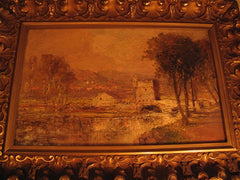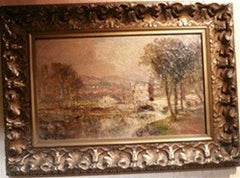



Signed Douglas Arthur Teed (American, 1860-1929), this oil on canvas depicts a pastoral scene of a river bend, European architecture and trees. Teed received praise for his impressionistic style, and he never followed the modernist movement with his contemporaries. He was very accomplished for portraits of members of Congress and the Supreme Court.
Per Wikipedia: The success of Teed's work is based on compositional harmony and a powerful maintenance of color value. Early attempts at figure drawing, such as "Angel Rescue", reveal a frustration towards the articulate separation of the subject from its surroundings. Thus began his treatment of the figure as an element in space, casting subjects against the romantic landscape – a vibrant rush of environment acting as a reflection of temper.
Accurate depictions of foliage, included with the abounding beauty of the countryside, were utilized by American artists at the time to create an awe-inspiring mood in their works. These were aesthetic tenets made popular by Sir Edmund Burke's treatise anticipating classical Romanticism, A Philosophical Enquiry into the Origin of Our Ideas of the Sublime and Beautiful. As Teed refined his aesthetic, he began to approach his subjects less as strict anatomical studies, and more in the vein of the foliage of the classical American landscape—in a delicate application of paint; as the vision which guided his hand, immemorial. In a Teed painting, we are asked to witness a scene which has fallen into the atmosphere, and plays on the same brush-stroke as of the sand in the wind.
Teed successfully developed his own philosophy on the "problems of light" (concentration/diffusion), popularized by the Barbizon artists. Many of his compositions are approached in concept of light. These techniques were first introduced to Teed by George Inness, in his own study as a disciple at the Barbizon School in Europe, starting in 1847.
The early influence of George Inness is clearly demonstrated within Teed's work; both practicing in a similar method, active in the same influences, emoting in the same key of atmospheric romanticism. Both Teed and Innes painted rapidly over wet paint. Teed was reported to have painted with a palette knife at great speed, able to produce a picture for a buyer in one night.
Unfortunately, this manner of work causes the paint layers to dry at different rates, creating extensive cracking and paint loss in a relatively short time. This is true of many of Teed's works today.
He remained a deep admirer of the arts throughout his life. Teed exhibited specific interest and influence in the works of Antoine-Jean Gros, Henri Rousseau, Jean-François Millet, Jean-Baptiste-Camille Corot, Jean-Léon Gérôme, George Inness, Claude Lorrain, Ludwig Löfftz, Eugène Joseph Verboeckhoven, and Jules Breton.
He studied every aesthetic style of the late nineteenth and early twentieth centuries, continually searching for a successful means of conveying his passion; compelled to portray on canvas the spiritual aura. He brought himself to the reaches of the planet in search of the mystics in Nature. Teed wanted to symbolize a reverence for God and Nature; he wanted to convey allegorical messages; he wanted his paintings to become his visual poetry.
Douglas Teed lived a quiet and humble life, never exhibiting the eccentric follies of the acclaimed masters he admired. His quiet did not mark a languid heart. There is a consistent temperament throughout his work, experienced strongest when seen in succession; a disconnected world, brooding and melancholy. In an article entitled "Distinguished Artist at Estero" (1905), one reviewer noted his painting's "...gravity of presence. With Mr. Teed, each image appears captured moments before the storm."[26]
Upon his return from Europe, Teed's canvases became highly acclaimed for their charm. The Boston Evening Transcript calls Teed "a man of high ambitions, with a fine sense of color, a just appreciation of values and a close observer of the subtle and delicate variations of the sensitive gamut... Rather than concentrate on specific forms, the artist has developed an overall pattern of color, light, and impasto which adds cohesiveness to the compositions."
His work no longer depicted simply the local morning picturesque. His landscapes were used as mirrors of his own complexion, both an interpretation of Nature's inner-spirit and his own. He staged "worlds of atmosphere, looking forth at us through ethereal light, through shadows..." Although he never chose to alleviate realistic representation altogether, Teed's paintings were largely the product of a passionate imagination, whose emotions materialized in the works' creation. The landscape had become subordinated to the thought.
There is a preference for the mystic and the exotic in his work. Early in his childhood, Douglas was exposed to various beliefs and theories through the oration of his father. No doubt, the vision Cyrus experienced concerning the Mother-Bride deity created an impression on the imagination of the young man. Both Cyrus and Douglas shared a propensity for idealism and didactic pursuits. There is a strong echo of Cyrus Teed's dogma in the work of his son.
Ultimately, Teed spent his entire life searching; through an emotional expression on the canvas, for inspiration in his travels around the world, in improvement of his method and evolution of style – searching for a "frankness and simplicity", stating, "simplicity is the most difficult of all things." He stands as an example of the continuous strain of romanticism used by American artists; heirs to the deep-seated religious, cultural, and intellectual convictions of a young nation founded on visionary daring and integrity.
Teed left behind twenty unfinished paintings when he died in 1929.
The work of Douglas Arthur Teed is currently housed in the Koreshan State Historic Site, the Arnot Art Museum, and countless private collections around the world.
Approximate Dimension: Outer gilt frame measures 17 1/2"H X 25"W
NOTE: Photographed in different lighting to depict color variations from warm browns to soft pastels.